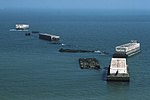Merchant's Railway
1826 establishments in EnglandClosed railway lines in South West EnglandHistory of DorsetHorse-drawn railwaysIsle of Portland ... and 5 more
Rail transport in DorsetRailway lines closed in 1939Railway lines opened in 1826Railways on English IslandsUse British English from July 2015

Merchant's Railway was a horse drawn and cable operated incline railway on the Isle of Portland, Dorset, England, built for the stone trade on the island. It was the earliest railway in Dorset, opening in 1826. The railway ran two miles from many working quarries at the north of Tophill, along the edge of Verne Hill, to a pier at Castletown, from where the Portland stone was shipped. It was in operation from 1826 to 1939. Since becoming disused the original path of the railway has become a popular public footpath.
Excerpt from the Wikipedia article Merchant's Railway (License: CC BY-SA 3.0, Authors, Images).Merchant's Railway
East Weare Road,
Geographical coordinates (GPS) Address Nearby Places Show on map
Geographical coordinates (GPS)
| Latitude | Longitude |
|---|---|
| N 50.565153 ° | E -2.442786 ° |
Address
East Weare Road
East Weare Road
DT5 1ES , Portland
England, United Kingdom
Open on Google Maps










